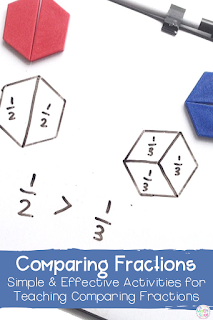We’ve made it! We’re at the last post in the 4 part fraction comparison series. If you haven’t read parts 1, 2, and 3, go back and begin there. Up until this point we have focused on teaching fraction comparisons by allowing students to have experiences that would promote understanding of fractions and fractional parts.
The concrete, representational, abstract (CRA) framework taught us to begin with concrete experiences and to link those experiences to both representations and abstract thinking. The focus of this post is concerned with promoting concrete thinking but, you may have noticed, that questions that point towards concrete thinking have been embedded in both the concrete and representational work that have been done thus far.
This is really the heart of the CRA framework- you are making links to abstract thinking all along the way! That is to say that abstract is not it’s own isolated step. I’m not saying students shouldn’t explicitly practice at the abstract level- of course they should to build fluency with the skill they are navigating. Students benefit from opportunities to access and apply their previous knowledge in order to become fluent in a skill. But, generally, “abstract” is not a stand alone step.
 Notice on day 1 when you introduced fractions with an “Epic” story problem. Right off the bat you What happens to the size of the piece of the candy bar as it is broken up further? What happens to the denominator of the fraction as the candy bar is broken up further? What do you think you might know about fractions as the denominator gets larger?
Notice on day 1 when you introduced fractions with an “Epic” story problem. Right off the bat you What happens to the size of the piece of the candy bar as it is broken up further? What happens to the denominator of the fraction as the candy bar is broken up further? What do you think you might know about fractions as the denominator gets larger? begin to ask questions that promote abstract thinking. I suggested that as you go through the Epic story problem that you chart what happens to the candy bar as more friends show up. Looking at that chart, it would be very logical to ask students
A powerful math lesson will tie together aspects of the concrete, representative and abstract within a lesson and will give students opportunities to make explicit connections.





